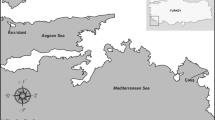Abstract
Two new species of the genus Octopus, discovered in the shallow water of the southern Caribbean, are described. Both octopuses are common in the local artisanal fishery. Octopus tayrona n. sp. is characterized by having 112 to 135 suckers on hectocotylized arm, a small ligula (LLi 0.42–1.62) with a calamus about one third to one half the length of the ligula, and ctenidia with 9–12 lamellae per demibranch. Octopus taganga n. sp. is characterized by having an ocellus between arm II and III, 80–85 suckers on the hectocotylized arm, and ctenidia with seven to ten lamellae per demibranch. A comparison with similar species is included.









Similar content being viewed by others
References
Arocha F, Marcano L, Cipriani R (1991) Cephalopods trawled from Venezuelan waters by the R/V Dr. Fridtjof Nansen in 1988. Bull Mar Sci 49(1-2):231–234
Berry SS (1953) Preliminary diagnosis of six west American species of octopus. Leaflets in Malacology, 1(10):51–58
Burgess LA (1966) A study of the morphology and biology of Octopus hummelincki Adam, 1936 (Mollusca: Cephalopoda). Bull Mar Sci 16(4):762–813
Diaz JM, Gracia A (2004) Primer registro de un pulpo de la familia Tremoctopidae (cephalopoda: Octopoda) para el caribe colombiano. Bol Investig Mar Costeras 33:283–286
Diaz JM, Puyana M (1994) Moluscos de Caribe Colombiano. Colciencias & Fundación Natura. 291pp
Diaz JM, Ardila N, Garcia A (2000) Calamares y Pulpos (Mollusca: Cephalopoda) del Mar Caribe Colombiano. Biota Colomb 1(2):195–201
Gleadall I (2004) Case 3263: Octopus hummelincki Adam, 1936 (Mollusca, Cephalopoda) proposed conservation of the specific name. Bull Zool Nomencl 61(1):19–22
Guerra A, Cortez T, Rocha F (1999) Redescripcion del pulpo de los changos, Octopus mimus Gould, 1852, del litoral chileno peruano (Mollusca, Cephalopoda). Iberus 17(2):37–57
ICZN (2006) Opinion 2147 (Case 3263) Octopus hummelincki Adam 1936 (Mollusca, Cephalopoda): specific name conserved. Bull Zool Nomencl 62(2):134–135
Leite TS, Haimovici M, Molina W, Warnke K (2008) Morphological and genetic description of Octopus insularis, a new cryptic species in the Octopus vulgaris complex (Cephalopoda: Octopodidae) from the tropical southwestern Atlantic. J Molluscan Stud 74:63–74
Mangold K, Hochberg FG (1991) Defining the genus Octopus: redescription of Octopus vulgaris. Bull Mar Sci 49(1-2):665
Montfort D de (1802) In Buffons Historie Naturelle (ed Sonnini) Paris 3: 38–54
Norman MD, Hochberg FG (2005) The current state of octopus taxonomy. Phuket Mar Biol Cent Spec Publ 66:127–154
Norman MD, Sweeney MJ (1997) The shallow water Octopuses (Cephalopoda: Octopodidae) of the Philippines. Invertebr Taxon 11:89–140
Norman MD, Finn JK ,Hochberg FG (2013) Family Octopodidae. In Jereb P, Roper CFE, Norman MD, Finn J (eds) Cephalopods of the world. An annotated and illustrated catalogue of cephalopod species known to date. Vol 3 Octopods and Vampire squids. FAO Species Catalogue for Fishery Purposes. No 4. Vol 3. Rome. FAO 370pp.
Pickford GC (1945) Le poulpe Americain: a study of the littoral octopoda of the Western Atlantic. Trans Connecticut Acad Arts Sci 36:701–811
Pickford GE, McConnaughey BH (1949) The Octopus bimaculatus problem: a study in sibling species. Bulletin of the Bingham Oceanographic Collection 12(4):1–66
Robson GC (1929a) A monograph of the recent Cephalopoda, part I: Octopodinae. British Museum (Natural History), London
Robson GC (1929b) Notes on the Cephalopoda, IX: remarks on Atlantic Octopoda in the Zoologische Museum, Amsterdam. Ann Mag Nat Hist Ser 10 3(18):609–618
Roper CFE, Voss GL (1983) Guidelines for taxonomic descriptions of cephalopod species. Mem Natl Mus Victoria 44:49–63
Verrill AE (1883) No. 5. Reports on the results of dredging, under the supervision of Alexander Agassiz, in the Gulf of Mexico and in the Caribbean Sea (1878-79), by the U.S. Coast Survey Steamer “Blake,” Lieut.-Commander C.D. Sigsbee, U.S.N., and Commander J.R. Bartlett, U.S.N., Commanding. XXV. Supplementary report on the Blake cephalopods. Bull MCZ, 11(5):105–123
Voight J (1988) Trans-Panamian geminate octopods (Mollusca: Octopoda). Malacologia 29(1):289–294
Voss GL (1950) Two new species of cephalopods from the Florida keys. Rev Soc Malacol Carlos de la Torre 7(1):112–120
Voss GL (1951) Further description of Octopus burryi Voss with a note on its distribution. Bull Mar Sci 1(3):231–240
Voss GL, Solis RM (1966) Octopus maya, a new species from the Bay of Campeche, Mexico. Bull Mar Sci 16(3):615–625
Voss GL, Toll RB (1998) The systematics and nomenclatural status of the Octopodinae described from the Western Atlantic Ocean. In: Voss N, Vecchione M, Toll RB, Sweeney M (Eds) Systematics and biogegraphy of cephalopods. Smithson Contr Zool 586, vol 2. pp 457–474.
Acknowledgments
The authors are grateful to Luis Sendoya, Lucero Zamudio, Juan Pablo Assmus, Julian Matos, Adriana Rodriguez, for their help in the fieldwork and lab; thanks is due to Ingo Stoessel and Tinka Stoessel for reading the manuscript, to Mike Vecchione and Bill Moser for their help at the Smithsonian Natural History Museum in Washington, to Ian Gleadall for making the photographs of the syntypes of Octopus hummelincki available for this study, to Carlos Alberto Trujillo for the samples of Isla Aguja, Michael Ahrens for the preliminary molecular study, el Ministerio del Ambiente de Colombia (survey permit SINA 03-2012), and Unidad de Parques Nacionales, Parque Nacional Natural Tayrona for their support.
Author information
Authors and Affiliations
Corresponding author
Additional information
Communicated by M. Vecchione
Rights and permissions
About this article
Cite this article
Guerrero-Kommritz, J., Camelo-Guarin, S. Two new octopod species (Mollusca: Cephalopoda) from the southern Caribbean. Mar Biodiv 46, 589–602 (2016). https://doi.org/10.1007/s12526-015-0406-9
Received:
Revised:
Accepted:
Published:
Issue Date:
DOI: https://doi.org/10.1007/s12526-015-0406-9




